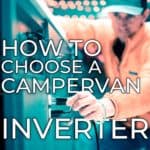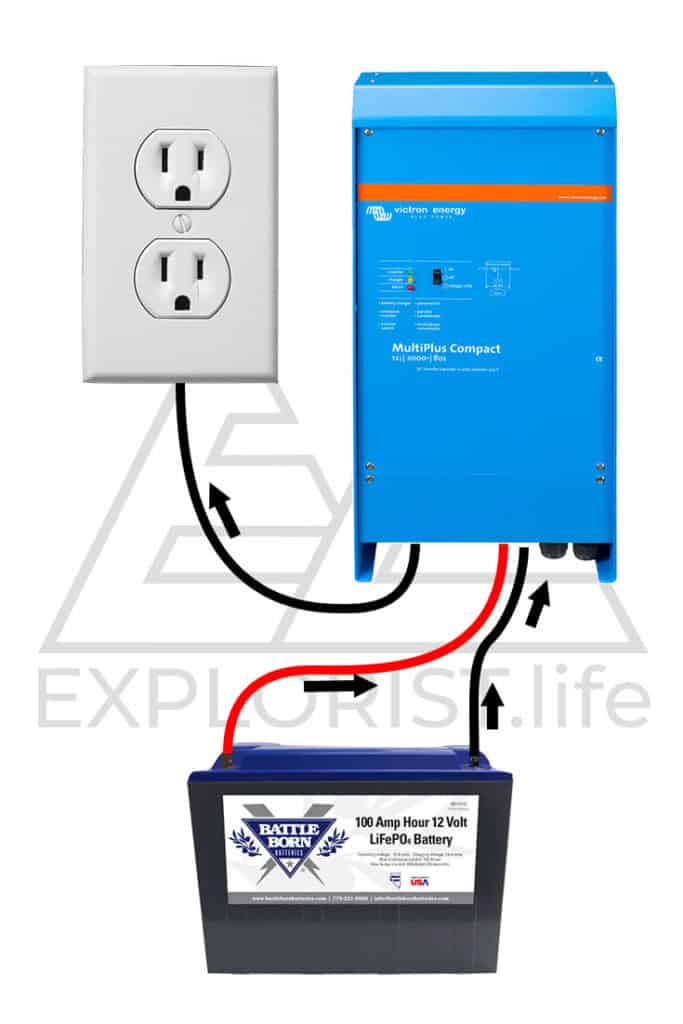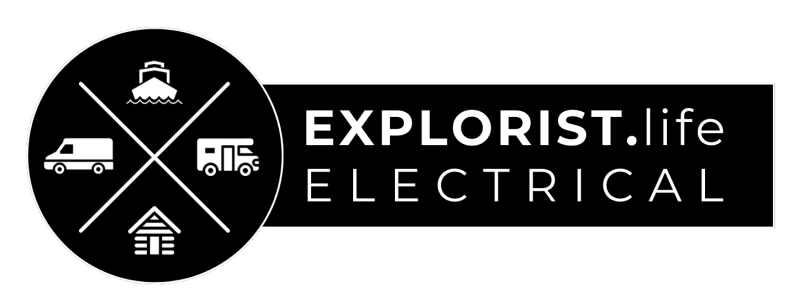
An inverter converts the 12v power of your batteries into the 110v power necessary to run electrical devices that normally plug into your standard household outlet.

Quick note before we get started. This is just one part of an overarching “How to Install a DIY Camper Van Electrical System” series. If you’ve just stumbled on this article directly without seeing that, there are likely some things we’ve already covered. If you want to check out that step by step guide, you can do that here: https://www.explorist.life/diy-campervan-solar
Also, we have interactive solar wiring diagrams that are a complete, A to Z solution for teaching you exactly what parts go where, what size wires to use, fuse size recommendations, wire lug sizes, and all kind of other stuff to help save you time and frustration. You can check that out here: https://www.explorist.life/solarwiringdiagrams/
What size of Inverter is Best for my DIY Camper?
This is a question with a VERY straightforward answer. Your inverter should be slightly bigger than the most power hungry electrical device you plan to power.
For example. Want to power something that uses 1800 watts? Round up and get a 2000 watt inverter.
If you’ve performed a power audit, you’ll remember that the calculator will actually recommend an inverter size for you based on your inputs.
If you haven’t done that yet, you should really consider checking that out here: https://www.explorist.life/what-size-of-solar-system-is-needed-to-power-a-camper/
For normal household outlet operation for powering items such as household coffee makers, coffee pots, toasters, blow dryers, and other power-hungry, but common household devices; I recommend a 2000 watt inverter.
A 2000w inverter will handle 15ish amps continuous AC power which makes it very similar to your normal 15 amp circuit in your house.
What’s the best type of Inverter?
You’ll be looking for a Pure Sine Wave Inverter. This inverter does the best job of mimicking the power that is ACTUALLY coming through a standard plug you can find in any on-the-grid wall. Square Wave and Modified Sine Wave aren’t recommended, because, the power they ‘Make’ isn’t a ‘clean’ power and can damage certain electronics and I can’t recommend those because I don’t like recommending products that have an inherent risk of damaging other equipment. If you want to save some money and go with a modified sine wave inverter but please do your due diligence and make sure the electrical devices you want to power are compatible with that modified sine wave inverter if that’s the direction you choose to go.
Cheap vs Expensive inverters
Cheap and expensive are pretty relative terms, but lets talk about these two inverters:
These are both good-quality pure sine wave inverters that I DO recommend in our wiring diagrams, but the Victron inverter is quite a bit more expensive than the Aims inverter. As of the making of this video, we personally have the Aims inverter in our van. Last year, we installed the Victron unit into my mom’s truck camper, so we have a bit of
The #1, biggest difference in the two is in regards to efficiency. For example:
On our Aims inverter, when it is simply on and not actually powering anything, it uses about 5 amps of power. Just being on… That means, that any time we are not using it, we have to be pretty diligent about turning it off.
If we had something we needed to run on 110v, say, overnight; during those 10 hours, the Aims inverter would use 50 amp hours out of your battery bank PLUS whatever electrical device you were actually using. So, if you had a 200 amp hour battery bank, the inverter would take 25% of your entire battery bank to be on overnight.
The Victron inverter on the other hand uses less than 1 amp to just be on. This means that It can be left on all the time with minimal negative effects on battery capacity.
Also, the Victron Inverter can be wired into a central monitoring hub. This will give you information about your system from your phone or even remotely via internet. This also allows remote access for troubleshooting. If you’re having issues with your Victron Inverter, a tech rep can log into your inverter, remotely, and change settings or help troubleshoot the device as needed.
Also, Victron is always making software improvements to their products and this remote access allows for firmware updates.
To recap: Both inverters I talked about are indeed good inverters, but the premium price you’ll pay for one over the other is for performance efficiency, more features, and potentially better customer service.
Inverter Chargers
If you plan on making a shore power inlet (which you should) so you can recharge from a campground power pedestal or just a wall outlet at home, you should consider an Inverter Charger.
An Inverter Charger will not only invert your 12v battery power to 110v power, but will also charge your 12v batteries from a normal wall outlet AND will run any electrical devices from that 110v normal wall outlet once the batteries are charged. This is nice for power hungry devices like electric space heaters or air conditioners.
Now that you’ve learned all about the inverter function of your Inverter/Charger, Lets dive a little deeper into the ‘charger’ function and learn how to add shore power to a DIY Camper Van. Check that out here: https://www.explorist.life/how-to-add-shore-power-to-a-diy-camper/
Everything that you are learning here is put to use in our FREE Interactive Solar Wiring Diagrams. If you haven’t yet, check them out as they are a complete solution for a camper van electrical system. Check them out here: https://www.explorist.life/solarwiringdiagrams/
Remember, this is just one part of a full camper van electrical educational series. To see all of the individual guides, click here: https://www.explorist.life/diy-campervan-solar
Finally, If you found this guide helpful, It’d truly mean the world to us if you’d share it with somebody who can use it, pin it to pinterest for later reference, or share it to a facebook group when somebody has a question about this subject. Click the bubble in the lower right corner to subscribe to be notified of future updates and as always, leave any questions you’ve got in the comments below.



47 Responses
Hi Nate,
Question, if the inverter/charger charges up to 120 amps and the battery has a charge rate of 50 amps will the battery BMS control the amount of amps coming in?
Can you direct me to a video that explains this, I could not find it.
Not likely. no. You’d want to limit the amount of amps coming from the inverter/charger.
Hi Nate,
Thanks for such great content.
I will be adding a Victron Multi plus inverter/charger to my motorhome but I would like some advice on the size if you wouldn’t mind.
I’ve done the power audit and I believe a 2000w would be enough. I’ve added 450ah of flooded Trojan batteries and I will be adding 3-600W of Solar later this year.
My question is since the 3000w inverter isn’t too much more cost than the 2000w, should I just spend the small amount extra to get the 3000 for some extra over head? Are there any drawbacks to over sizing in this situation?
31’ motorhome
3000w Onan Generator
30amp shore power
There is really no drawbacks other than cost. You’ve got enough battery capacity to support the Multiplus 3000. Here is a diagram that shows how to integrate the Multiplus 3000 into a 30A OEM RV: https://www.explorist.life/30a-camper-inverter-with-solar-and-alternator-charging-wiring-diagram/
@Nate Yarbrough, thanks Nate. Is there a way to purchase it so you make a commission? Do you have an Amazon affiliate link for the MP3000?
If you click on nearly ANY link on this site before purchasing, I make a commission. I actually HIGHLY recommend NOT purchasing your Multiplus through Amazon. Although you will indeed receive the product, not all of the sellers have good post-sale customer support if you need help setting up your inverter. For that reason, I recommend buying Victron products through Battle Born Batteries (They are a Victron distributor). Here is a link for the multiplus on their site: https://battlebornbatteries.com/product/victron-multiplus-inverter-charger-3000w-12v/?afmc=explorist_bb67
I’m set on Victron for the quality and brand direction. Victron does make the purchase decision difficult with their 2000K vs 3000K multiplus! The cost difference is so minimal for the upgrade to the 3000K unit. I know the wiring size needed is different and that would add to the cost difference. Any idea on a rough overall cost difference (in wiring) with all the experience you have in installing either version?
I’m installing 300 AH of lithium batteries and upgrading an older 2008 Sprinter van build that had 225 AH 6v AGM. Pretty much rewiring the entire system to go with Victron and keep it all matching and simple. Needed to replace the solar charger and battery controller anyway to use lithium.
Do you ever install a Blue Sea LVD in your systems? Thoughts?
The cost between the two wiring setups would be about, let’s say, $200. That’s just a guess. You could actually cross reference by using the shopping list on the two different systems found here: https://www.explorist.life/solarwiringdiagrams
BUT… The 3000k Multiplus REALLY needs a minimum 400Ah of batteries to function flawlessly and I can’t recommend running that Inverter with only 3x batteries.
I do not use the Blue Sea LVD in any of my systems.
If I want to run an 1800W induction stove and 1800W toaster oven at the same time I would need a 4000W inverter. But you mentioned something about a 2000W inverter provides around 15A service. So a 4000W inverter provides around 30A? And if so would I need to 15A circuits coming off the inverter?
You are indeed correct in your math. Watts / Volts = Amps
Do you have an idea of the efficiency of the Renogy 1000w Inverter & Charger?
I don’t. I have yet to test one, but I would imagine it is similar to the AIMS inverter/charger I mentioned.
Hey Nate: I really enjoy your DIY videos and tutorials.I I have a learned a lot…thanks for producing them.
I have a truck camper on order, and I am in the process of designing the solar system including selecting an inverter. The space in the battery compartment is limited, and it appears that I will only be able to fit an inverter or solar charge controller but not both. Which one (inverter or charge controller) should I mount in the battery compartment and remote mount the other (inverter or charge controller)? I appreciate your input on this subject…thanks in advance.
It’s more important to have your Inverter closer to the batteries that the charge controller… so whatever configuration that means in your setup.
Hi guys! silly question: if im not planning on having any normal appliances does that mean i can go without an inverter? (obviously I know down the track i MIGHT want to, but budget wise i want to get started and can upgrade later).
If I’m just charging my macbook, phone, drone, 12v fridge etc. Can I go without an inverter?
If you can find the proper converters, you can indeed do that.
Hi Nate,
Thanks so much for all your great info here, its truly invaluable! I had a question on your experience with inverters…
Based on your wiring diagram, and most others I’ve seen, you basically have the solar (or other) charging the batteries, and then the batteries alone powering your inverter. Have you seen any inverters that accept two inputs, one from the batteries and one from the solar?
The reason I ask is in an attempt to power AC devices directly from the solar, and reduce cycling on the batteries. I work for a company that does combined solar+battery systems for the grid, our system basically works like that. Using one combined DC/DC+Inverter device that accepts power from the solar, it can either send solar power to the batteries through the DC/DC, directly to the grid through the Inverter, or a bit of both.
I thought this kind of configuration could make sense for vans in order to increase battery life. I’ve done some searching, but haven’t found any small scale “DC-coupled” style inverters like this, so I was wondering if you’d heard of this being used in vans?
Sorry for the long wind, really appreciate any wisdom you have on this!
Thanks, Noah
Basically no… Like you said, there are no small scale units that do this that I am aware of.
Hi
I’m planning on living in a tag along 22ft camper full time. I want to use solar power. There is a microwave and the biggest thing I would be using is a sewing machine plus a television. What would your recommendations be for that type of usage? I have no clue whatsoever and need all the help I can get.
Thanks
Penny
You should perform a power audit and let it recommend an inverter size for you: https://www.youtube.com/watch?v=a406IxiU-Xg
Hi! Your blog and this series are super helpful while we prepare for our own van life! My question – for shore power, can you still use your AC and DC electric while your batteries are charging via shore power? And is the input from your panels switched off in the inverter, or are you using solar and shore power to charge your batteries? Finally, does it make sense to run a separate AC distribution for appliances like air conditioning that might only be run while hooked to shore? Thanks 🙂 (Sorry if you’ve already addressed this and I haven’t got there yet…)
When connected to shore power, shore power will first go to power any AC devices in your camper. The left-over will go to charge your batteries, which are simultaneously allowing you to use your DC appliances.
I don’t like the idea of a separate AC distribution for appliances like the air conditioner. It adds complexity to the system when that ‘problem’ could be solved by simply not turning on the air conditioner when not onshore power.
Would your wiring kit “3000w – 150v – 600Ah Camper Solar Wiring Kit” work with a 3000w victron inverter charger, 340amph lithium batteries and 340w solar panels and 100 mppt charge controller, without charging from an alternator? Do you sell custom wiring kits? Thanks!
Apologies, but I do not sell custom wiring kits. There are a few sizes of wires in my kit that would not work for your setup (the wire I include from the charge controller to the batteries is 2 AWG which would not fit in the 100V MPPT charge controllers.
Hi, this question may be super naive. But, do I need an MPPT charge controller when my inverter is mppt based?
I’m not sure what an MPPT based inverter even means. What inverter do you have that is saying it’s an MPPT inverter?
Is there a downside to having a 3000 watt invertor vs a 2000 watt, if I only need to power an induction stove and a Vitamix? Also, a lot of vanlifers claim that their 2000watt wasn’t strong enough to handle their Vitamix and had to upgrade their invertor. Thanks.
A 3000w Inverter will just be more expensive and require larger wiring; but if you need it, you need it. A 2000 watt Victron Multiplus like shown on all of our diagrams could handle a vitamix by itself no problem, but would have little wiggle room for powering other items at the same time.
Thanks for all the info Nate. I was gifted two 300w 24 V panels and trying to determine the type of inverter I would need to use. Will it also need to be a 24 V to match the panels… And can I use these with two 12 V batteries in parallel
We’ve got a few wiring diagrams using 2 x 300w solar panels you can check out for examples of how they could work in a system: https://www.explorist.life/solarwiringdiagrams/
Hi Nate,
I was wondering if theres any downside to have an Inverter/Charger combo. Let’s say I am plugged into shore power, and I want to charge my batteries and run my DC stuff but not my AC, is there a way to say “only use the charger and not the inverter”? I’m mostly concerned about noise.
Yep! When you are plugged into shore power, the power just ‘passes throigh’ so the inverter isn’t really even on…basically. So yeah, theres no noise in that case.
My dad already has a PowerDrive 3000 Watt Power Inverter. Can I use this as an alternative and switch to a pure sine wave inverter in the future when my budget is more felxible? I’m planning on running a system that consists of 4 lithium batteries & 3 x 280w Solar Panels. Also wondering if I can use a Lithium Iron Phosphate battery instead of Lithium Ion?
At the risk of sounding snarky, which I’m not trying to be… You can do whatever you like. I know that’s not much help; but I’m not sure of a more thorough way to respond.
Hey Nate, I couldn’t find the correct place to ask this question I hope you’ll comment. The Blue Sea ACR, I think you installed something like this on your build. Do you remember how it installed? The directions are a little vague. Does it need a wire to the ignition somehow? Next question would be with your overkill system (lol) did you ever use it? I have plenty of solar and have been thinking of installing one of these for the winter months. I know you did a lot of winter sports so I thought I would ask. Thanks. Really enjoy your build videos.
The directions are indeed super vague, but we never made a tutorial over how to wire in the Blue Sea ACR. Sorry about that! It will, indeed, need a wire to the ignition though. We don’t always charge via the alternator but it’s VERY nice to have when we do need it. Also, during those winter months when the starting battery needs to be jumped, we can combine our house and starting batteries through the isolator to ‘jump’ ourselves with the push of a button. Pretty sweet.
what wire crimpers do you use? Thanks
If you’re talking about big crimpers for 2/0 wire and such, I’m in love with these: https://amzn.to/31NEy5C
For smaller wire (10 – 22 AWG), I like these: https://amzn.to/33MvJuI
Hey! Found your site while I’ve been wrestling with different products for my solar electric system… Wish I’d of found it sooner!
While I’d love to include a Victron, they’re unfortunately way out of my price range. I’m debating between the AIMS 2000W and their green 2500W model. Wondering if you can give me any advice.
Obviously there are some differences, I just don’t know how crucial those are for vanlife. The price of the green makes it appealing of course. I know it has a larger idle draw and doesn’t have some of the bells and whistles of the other.
Any info you may be able to provide to help me sort this decision out would be much appreciated. Thanks!
The AIMS inverters are definitely good as well. Unfortunately, without really diving in, I don’t know the differences between the two models you mention.
any thoughts on Samlex America PST-2000-12 PST Series Pure Sine Wave Inverter? Thanks
Nope. Haven’t really researched that particular one yet.
thanks Nate — your series on electrical solar shore and alternator power is proving incredibly valuable as I design and start to put together my system.
You both have done a great job building your website, packed full of great information.
We are planning to start our build. Looking to install a 12volt system, with on shore power hook up.
Can you tell us if the AIMS inverter / charger work with all lithium batteries?
We cannot speak for ALL lithium batteries, but they will indeed work with Battle Born Batteries.
I’ve been looking into both the AIMS and the Victron I/Cs you mention . . . curious to understand how you’re arriving at the statement that the AIMS using 5 amps while just on. The specs on their site indicate only 28 watts of idle consumption and 12.7 when in “power saver mode.”
Here’s the link to the specs: https://www.aimscorp.net/2000-Watt-Pure-Sine-Inverter-Charger.html
So, only 1 amp, or 2.4 if not in power save mode. Has the AIMS been upgraded since you wrote this post maybe?
That stat was based on me having both inverters and side by side testing them through a shunt. Maybe my Inverter is faulty, or they have upgraded, but it definitely uses more than 28w at idle.